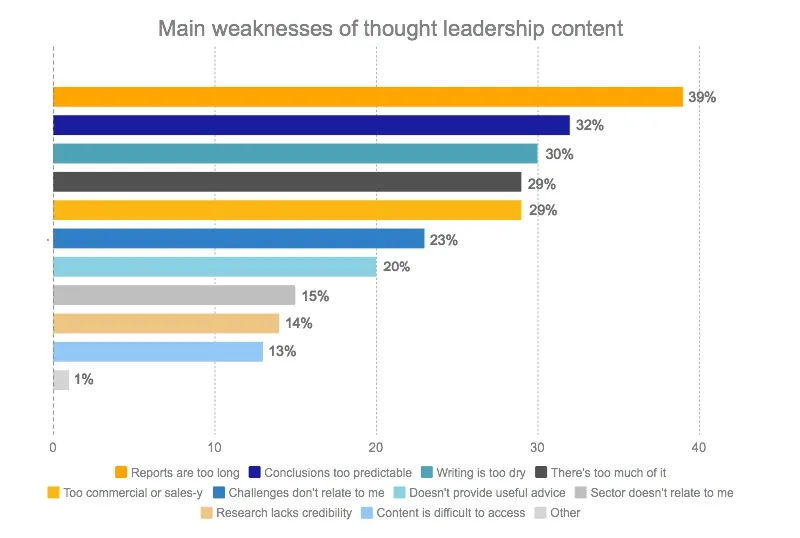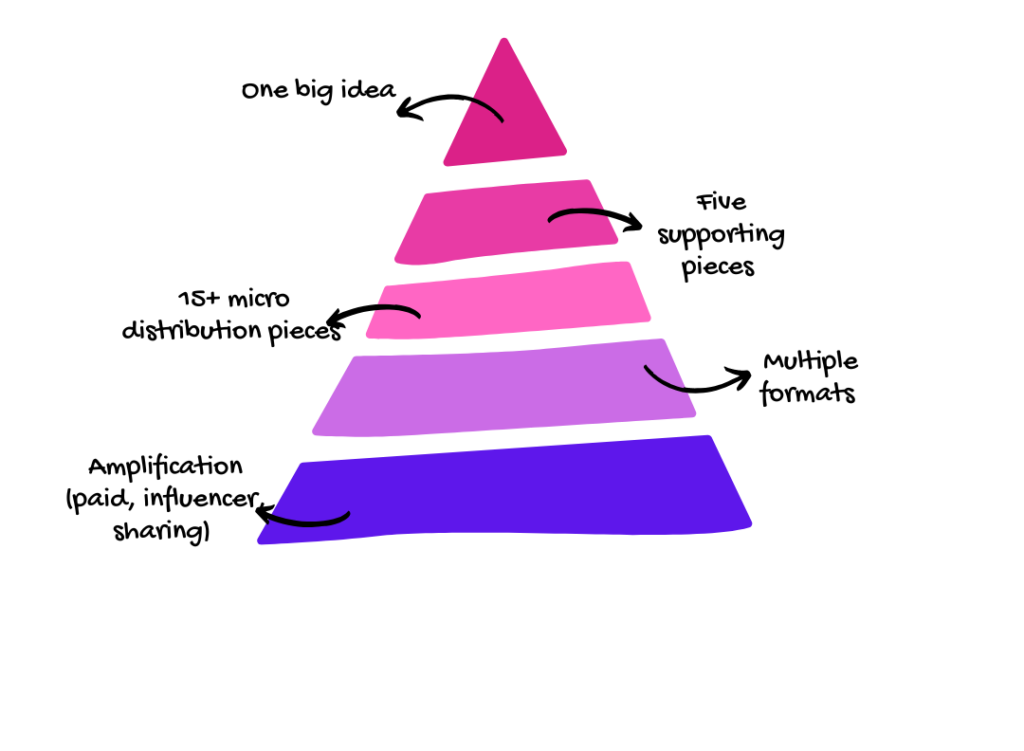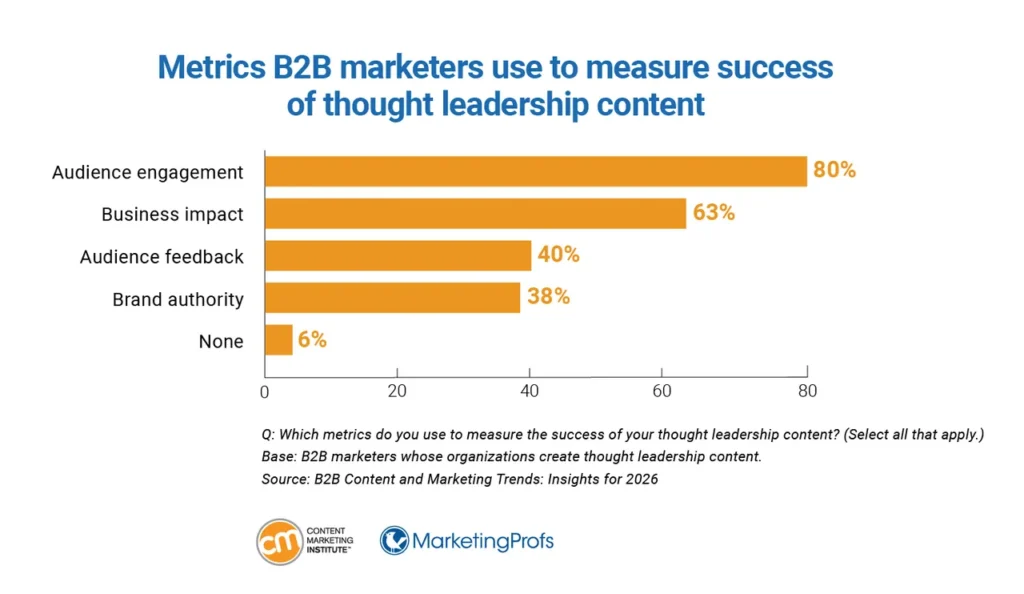November 12, 2025
Oh, it’s so easy to talk Thought Leadership
It’s not so easy to make it happen
Thought leadership is how you build trust through expertise. You show your working, go deep on the messy bits, and nudge behaviour change over time. It’s the essential core of the way modern buyers are making purchasing decisions.
The data shows this to be the case. 95% of hidden decision‑makers become more receptive after strong thought leadership, 71% say it demonstrates capability better than product sheets, and they prefer distinctive, human formats with quick takeaways (60% and 57%) (Edelman–LinkedIn 2025).
After all, business is still the most trusted UK institution, but credibility sits with real experts, not logos (Edelman UK). It’s going to be the big topic of conversation at the B2B SocialDay event today.
What thought leadership actually does
It makes you the answer when a buyer searches, asks AI, or posts a question on LinkedIn. It positions your people as the experts worth following, hiring, or partnering with. It turns cold prospects into warm leads who already understand your worldview before the first call.
Thought leadership supports every stage. Prospecting, pitch support, deal progression, account expansion. 87% of B2B decision-makers prefer content from trusted industry influencers over brand messaging (Limelight B2B Influencer Benchmarks 2024). That means your CEO on video explaining a trend beats your corporate deck every time. It’s why trust beats virality every time
FFS you need to have thinking to be thought leadership!
Thought leadership is your real expertise made useful. It puts a clear point of view on the table, shows your working, and helps buyers change how they approach the problem over time. It gives them language to take into the room, the numbers to weigh risk, and practical steps they can act on.
It’s clarity, originality and proof in a human voice, published with consistency. That’s why buyers treat it as a truer signal of capability than brochures, and why it helps groups align faster.

And that is especially true of the hidden influencers who never meet you (Edelman–LinkedIn 2025). Hidden buyers prefer distinctive, perspective‑shifting ideas and quick, human takeaways over academic deep dives (Edelman–LinkedIn 2025).

So many moving parts
We all know that buying now happens in dynamic networks influenced by partners, social voices and AI answer engines; discovery is compressed into citations and community proof. Hidden decision‑makers look for credible, human experts they can quote internally, and they trust evidence‑led POVs more than brochures (Edelman–LinkedIn 2025).
The real work is building the support around the thinking so it actually lands. Keep it simple and tight:
Ecosystem checklist
- Small editorial group with clear sign‑off and a weekly cadence
- Monthly pack of with POV, data, sources and approved stats
- Protected filming and writing time in leaders’ diaries
- Canonical Q&A pages that are AEO‑friendly, with bios and original proof
- Simple rules for LinkedIn, YouTube and communities, and a consistent look and voice
This takes time on purpose, it’s how leadership becomes leadership (by doing the audience work, defining the trade‑offs, showing numbers, and doing it all with consistency). Do that and you earn trust across the networks where buying happens, from hidden influencers to AI answer engines
It doesn’t stop at the content though
Distribution matters just as much
Your smartest insight dies if no one finds it. Social and AI search now drive discovery; email and newsletters hold attention; consistency compounds both. This isn’t about being everywhere. It’s about being where buyers look when you’re not in the room.
Where buyers find you has shifted
Social media is the number one source of qualified leads in 2025 at 46%. AI search platforms like ChatGPT and Perplexity come second at 34%, ahead of organic search at 30%, email at 29%, and paid media at 25% (10Fold Content Survey 2025). Discovery has fragmented. Buyers start on LinkedIn, ask ChatGPT for a shortlist, then search your name to validate.
That means your thought leadership needs to work in three places at once: social platforms where it gets shared, AI engines that cite clear and sourced human content, and traditional search where people look for you by name after they’ve already decided you’re worth investigating.
65% of B2B marketers still distribute content via Google and browsers, but 56% now also use AI-native platforms (10Fold Content Survey 2025). This isn’t either/or. It’s duality. You optimise for AI discovery while still aligning with traditional SEO because your buyers use both.
Channels that keep you in the room
Social media is the most-used channel for B2B marketers at 75%, followed by email at 61% and email newsletters at 50% (LinkedIn B2B Benchmark 2024). Newsletters work because they arrive when buyers are ready to think, rather than when the algorithm decides to show your post. A weekly drumbeat across LinkedIn, YouTube, and a decent newsletter keeps you present in the spaces where decisions happen.
53% of marketing leaders already have a dedicated Social Search strategy, and 46% are experimenting with one (Sprout Social CMO Guide 2026). Social search means people typing questions into Instagram, TikTok, Reddit, and LinkedIn instead of Google. If your thought leadership isn’t optimised for how people actually ask questions in these spaces, you’re invisible to half your audience.
Consistency compounds the message
93% of B2B marketers are developing or testing AI-optimised content (10Fold Content Survey 2025). Most are using metadata and tagging, expert-authored content, and structuring for natural language queries. The brands winning this race publish consistently across multiple formats: a LinkedIn post becomes a 60-second video, a blog optimised for AI citations, and a newsletter that goes deeper.
One professional services marketer at an FT Longitude roundtable described how they transform their annual CEO survey into brand-level reports, social content, sales presentations, executive briefings, and interactive data tools. Same insight, multiple entry points. That’s the flexible format model that actually gets used.
Publishing cadence isn’t about volume for the sake of it. Engagement increased by nearly 20% from 2023 to 2024 even though publishing volume decreased (Sprout Social Impact Report 2025). Quality beats frequency. But quality published weekly beats quality published whenever you remember.
Where most brands waste the work
They create a brilliant piece of thought leadership, publish it once on LinkedIn, and wonder why it didn’t move the needle. Distribution is the work. One format isn’t enough. One channel isn’t enough. One moment in time definitely isn’t enough.

If your smartest brains only produce glossy PDFs that live on a resources page behind a form, you’re not building trust. Those PDFs should be disaggregated into LinkedIn carousels, video explainers, newsletter deep dives, and canonical Q&A posts that answer the exact questions buyers type into search bars and AI tools.
Video is the most effective content format at 37% for lead generation, followed by LinkedIn articles at 31% (10Fold Content Survey 2025). Yet most thought leadership still lives as text-only blog posts that no one reads past the first paragraph. Turn your best insights into 60-second vertical videos where your CTO or CEO explains the thinking in their own words. That’s what buyers save, send, and cite in meetings.
The practical distribution checklist
Pick your best piece of thought leadership from the last quarter. Turn it into five formats: a LinkedIn post with a clear point of view, a 60-second video, a newsletter article, a carousel with data visualisations, and a blog post structured for AI citations with clear headings and natural language.
Publish it across three channels minimum: LinkedIn for social discovery, your blog for search and AI, your newsletter for owned audience. Track what happens to saves, sends, branded search volume, and profile visits from target accounts over the next six weeks.
Then do it again next week.
80% of B2B marketers measure thought leadership by audience engagement. Only 6% measure nothing at all.
That sounds reassuring until you look at what engagement actually means. Likes, impressions, downloads counted on day one. Vanity dressed up as rigour. Meanwhile, 79% of leaders with mature thought leadership programmes score highest on measurement capability (Momentum ITSMA 2024), which suggests most of us are measuring the wrong things entirely.

What actually moves the needle
86% of buyers are moderately or very likely to invite a company to tender after engaging with strong thought leadership (WARC 2024). 55% of decision-makers increased business with an existing provider because of that provider’s thought leadership These are commercial outcomes, not engagement theatre.
41% of target buyers and 35% of hidden buyers were encouraged by a C-suite executive to consider a vendor after engaging with that vendor’s thought leadership. Someone senior read your content, found it credible, and brought your name into the room when you weren’t there. If you’re not tracking that, you’re missing the point.
Trust signals that predict deals
Your thought leadership isn’t just educating one buyer; it’s the artifact they use to convince finance and operations that this purchase makes sense. If you’re measuring clicks but not internal forwards or saves, you’re blind to how buying actually happens.
Track how many opportunities cite your thought leadership in discovery calls. Measure branded search after major releases. Count sales usage in active deals. Monitor saves, sends, and profile visits from target accounts. Segment by seniority and format. Set a quarterly review: which content showed up in closed deals; which drove high-value engagement; which generated advocacy.
And remember, trust is the new KPI
So there you have it. All the key reasons why thought leadership matters, what you need to consider doing and how you can measure it.
Oh, and if you want to know how Ai can help, give us a shout at immediate future and we’ll tell you how to speed up this whole process
